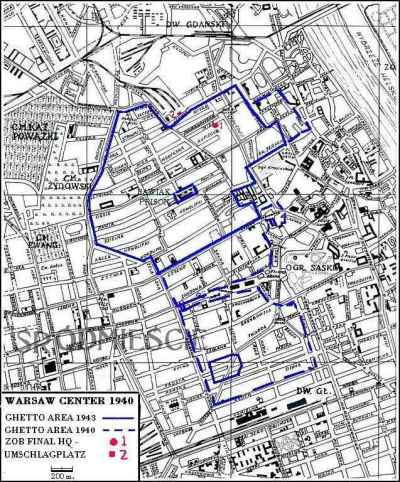 |
SYRENA MAPS WARSAW GHETTO 1940 - 1944 |
Bill Biega's Information Series |
|
Biega Home Page
Computer Help Special characters, colors. East Europe Cities, Countries, Info. History Genealogy, History Essays Maps Cities, Countries, Historical Photo Gallery Places I visited Rydzyna Sailing all over the world Syrena Press 13 Is My Lucky Number Learning LINUX 
Contact us by Email |
Click on map to see it full size. Then click on "Back" button to return to this page.
Warsaw was occupied by the German armies at the end of September 1939, after a siege which lasted 20 days. The Jews of Warsaw were subjected to even harsher treatment than the rest of the population. First they were obliged to wear
yellow Stars of David on their clothes or on an arm-band. Then they were evicted from their homes and flats and
forced to move into the already crowded Nalewki (pronounced NA-LEVKI) district, which for the last 100 years had been populated primarily
by poorer Jews - laborers, shopkeepers, artisans. The non-Jewish population of the area was evicted. The overcrowding was increased by the transportation
of Jews from other Polish towns, especially those in Western Poland which had now been incorporated into the Reich itself.
In 1941 the Nazis started shipping to Treblinka and Majdanek those considered unable to work. The trains were loaded at the Umschlagplatz. By this process and the death of thousands due to disease and starvation and the execution of hundreds more, the size of the Ghetto was reduced to less than half at the end of 1942. By Passover 1943 only some 50,000 remained. As the Nazi troops moved in on April 19, those remaining fought back. On May 8th. the ZOB (Jewish Fighting Organization) headquarters at Mila 18 were surrounded and all inside perished, together with the leader of the ZOB, Mordecai Anielewicz. On May 16, the Nazi SS General Stroop reported to Hitler that the fighting had ended and that "... the Jewish quarter of Warsaw no longer exists." Nevertheless, sporadic fighting continued in the smoking ruins for several weeks longer. For more information about the Warsaw Ghetto see the sources listed by
Jennifer Rosenberg.
I highly recommend the film "Pianist," produced by Roman Polanski in 2002, which provides a stark picture of the reality of life in the Warsaw Ghetto from its inception in early 1940 till the final battle in 1943. It very truthfully follows the text of the auto-biography written by the pianist of the story, Władysław Szpilman, who miraculously survived. The film received the Palme d'Or at the Cannes Film Festival in 2002. The map above will serve as a good reference to all viewers of the film. Return to Top of page. Return to Maps Table of Contents]. |
|
Last update May 2002 |
